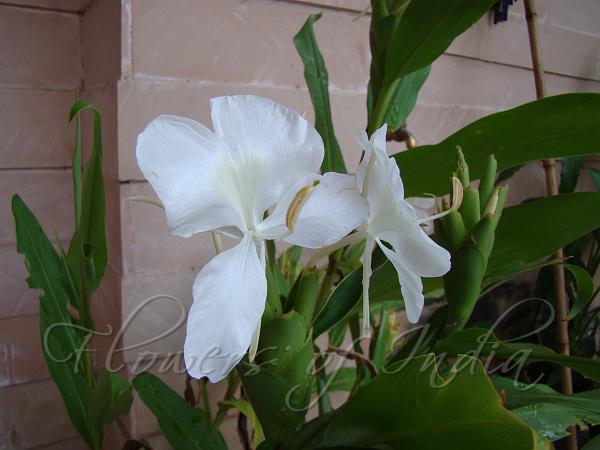|
| Butterfly Ginger Lily |
|

|

| File size | 2988650 |
| Original date | 9/4/08 8:19 AM |
| Resolution | 3456 x 2592 |
| Flash | Flash did not fire, auto |
| Focal length | 5.2mm |
| Exposure time | 1/160s |
| Aperture | 4.0 |
| Focus Distance | |
| Metering Mode | Multi-segment |
| Camera make | SONY |
| Camera model | DSC-H50 |
| Sensor type |
|
|
|
Photo: |
Botanical name: Hedychium coronarium Family: Zingiberaceae (Ginger family)
Synonyms: Hedychium maximum, Hedychium sulphureum, Hedychium spicatum G.Lodd.
Synonyms: Hedychium maximum, Hedychium sulphureum, Hedychium spicatum G.Lodd.
Butterfly ginger lily is beautiful and fragrant flower native to East India.
It is a robust,
attractive plant that will reach 6 feet in containers. Leaves are lance-shaped
and sharp-pointed, 8-24 in long and 2-5 in wide and
arranged in 2 neat ranks that run the length of the stem. From midsummer
through autumn the stalks are topped with 6-12 in long clusters
of wonderfully fragrant white flowers that look like butterflies. The flowers
eventually give way to showy seed pods chock full of bright red seeds.
The rhizomes of Butterfly ginger lily (called loklei) are used in Manipur
in the preparation of traditional dish called as eromba.
Butterfly ginger lily is found in the Eastern Himalayas, from Nepal,
to Sikkim and NE India, and also Western Ghats, at altitudes of 800-1900 m.
It is also found in SE Asia, and is widely cultivated as a garden plant.
Medicinal uses: Extract of rhizomes is given in
bronchitis. Decoction of rhizomes is used for gargling in tonsillitis
or simply as a mouth wash to avoid bad breath. The herb is used as a
febrifuge, tonic and anti-rheumatic. Rhizome paste is applied on bruises
and sprains.
Extract of rhizomes is given in
bronchitis. Decoction of rhizomes is used for gargling in tonsillitis
or simply as a mouth wash to avoid bad breath. The herb is used as a
febrifuge, tonic and anti-rheumatic. Rhizome paste is applied on bruises
and sprains.
Medicinal uses:
 Extract of rhizomes is given in
bronchitis. Decoction of rhizomes is used for gargling in tonsillitis
or simply as a mouth wash to avoid bad breath. The herb is used as a
febrifuge, tonic and anti-rheumatic. Rhizome paste is applied on bruises
and sprains.
Extract of rhizomes is given in
bronchitis. Decoction of rhizomes is used for gargling in tonsillitis
or simply as a mouth wash to avoid bad breath. The herb is used as a
febrifuge, tonic and anti-rheumatic. Rhizome paste is applied on bruises
and sprains.
| Identification credit: Tabish | Photographed in Rishikesh, Uttarakhand. |
• Is this flower misidentified? If yes,